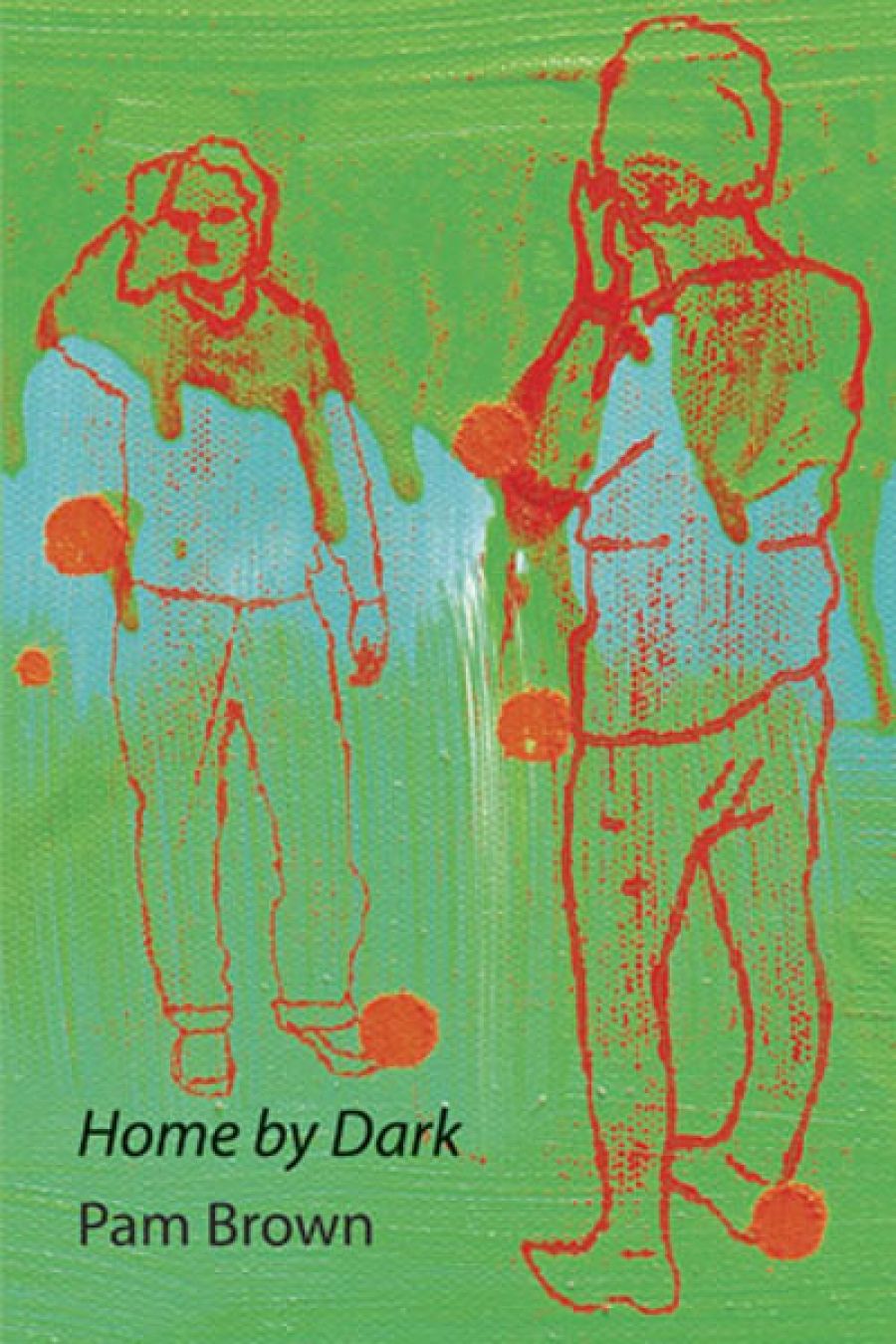
- Free Article: No
- Contents Category: Poetry
- Custom Article Title: Gig Ryan reviews 'Home by Dark' by Pam Brown
- Review Article: Yes
- Article Title: The gleaner
- Online Only: No
- Custom Highlight Text:
Home by Dark is Pam Brown’s seventeenth book. She has also published ten chapbooks, including two collaborations. Brown’s poems are mostly elliptical, pithy, hewn into slight lines that imply or jest. Each poem manoeuvres and collects the everyday. It is an aesthetic of accumulation, a bricolage that ...
- Book 1 Title: Home by Dark
- Book 1 Biblio: Shearsman Books, $23 pb, 131 pp, 9781848612884
Home by Dark, as its title suggests, considers change and loss. The first poem, ‘Windows wound down’, traces one month like a mini-‘Shepherd’s Calendar’ (noted in her earlier ‘Text Thing’ [2006]). The poet memorises Keats and Thom Gunn, immediately positioning herself between the present’s incongruously shiftless pluralism and a linear tradition, as well as the compact of consciousness as memory. Other poems swipe at accepted paradigms of containment and closure: ‘is this a / sappy nature poem?’ (‘Feed the Orchid’). The poet finds an old lover’s note in a book, itself a reliquary of memories that in turn infiltrate the poem. This section ends with a haunting double-vision of ‘1988’ in which past and present collide.
Other poems informally but humorously contrast consumerism and the subjective life of the poet. Home by Dark shuttles between the cracks of past decades in a compulsive yet wayward flux, processing a world inseparable from the poet, a participant, not a superior unclinched observer. Each captioned tableau drags the world onto the poem’s map:
can poetry do it though,
specifically, address the problems
from the sofa,
when the world erupts
in high definition,
dictatorships crack and collapse,
corporate investment implodes,
can’t poetry follow?
(‘Dry ice’)
Among the poets referenced here are James Schuyler, Hope Mirrlees (whose ‘Paris’ is regarded by some as a forerunner to ‘The Waste Land’; Brown’s ‘American Memories, Melbourne’ pays homage to Mirrlees), and contemporary Americans Rachel Blau DuPlessis, Susan Schultz, Eileen Myles, and Fanny Howe. DuPlessis’s long poem ‘Drafts’ bears some similarities to Brown’s inclusive oeuvre. Other literary ancestors are Frank O’Hara and Gertrude Stein: ‘some viridian / in my opinion’ (‘Windows wound down’), as well as Steinian titles such as ‘Rehab for Everyone’, which echoes Stein’s Everybody’s Autobiography. Nothing is beyond the poem – ‘kids are rolling / down a mound / of irradiated tilth ... a tiny plastic ‘T’ / snipped from / a price tag / caught in the mat’ (‘Closed on Mondays’). She also shares an often defiantly comic tone with colleagues Ken Bolton, Laurie Duggan, and joanne burns: ‘my task – / reinvigorate ossified poetries / by adulteration ... // click on the link / or leave until morning? // sleep the computer’ (‘More than a feuilleton’).
Home by Dark is divided into five sections. The last three contain the tightest work, as if the love note of the first poem has opened all memories, cantilevering outwards, enriching as it expands, with some gracefully slanted elegies, and poems where computer dictates (‘add to cart’) invade the poem, indicating existence as contingent on technology. Humour and a mock-seriousness deflect from any innate seriousness of intent: ‘sometimes the clunky / can incandesce / but I want to know / how to vitalise gawkiness’ (‘Rehab for Everyone’).
Poems observe how an autonomous unplugged self no longer exists: ‘canned laughter / does my laughing / for me’ (‘Seriously’). Such progress measures distance from the past: ‘death’s announced / to / a quick declivity / (joke) / of upload, list & link – / scrolling, / the final ritual // mourners weeping, / for themselves’ (‘Closed on Mondays’), and scrolling down a screen becomes the last worldly activity. But the syntax is ambiguous, as in the last line of ‘Living’:
mothy inkblots are a cult hit,
complacency is no fun
but it is, in your case, restful
sceptical optimism - a phrase that jars
as it claims its triumph
like plastic’s morbid persistence
atmosphere’s leaden now you’ve said that,
done and gone, poorly.
nothing left marvellous, only living
(‘Living’)
Brown’s commitment to a spontaneous self-narrating postmodernism slugs it out in creative tension with political commitment’s desire to be understood, though politics is less apparent here than in earlier volumes. Her poetry, though lyrical, is not relaxed or spooled into conversational style, but an adhesive shorthand of sights and thoughts and the chancy but less compelling slippages have receded with each book.
Small details become emblematic of an era, as in her reference to ‘the dead princess’, but more often to pop songs or habits: ‘satellites police the stars ... // acquit me of my consternation, / is this my holiday? // pollination is a dying art // the dead princess’s car wreck / up for auction’ (‘Holiday Guide to Everything’). These glimpsed shards form the tesserae of the poem / the self – not fixed (like the stars), but fluid and multiple. Among the best poems are ‘Spirulina to go’, ‘Leaving the World’, ‘What’s the Frequency, Kenneth?’, ‘More than a feuilleton’, ‘Nina Hagen’, ‘Living’, and ‘iNext Twilight’. Pam Brown is a constantly questioning presence, a gleaner, whose work over forty years has been whittled to the essentials of its style.


Comments powered by CComment